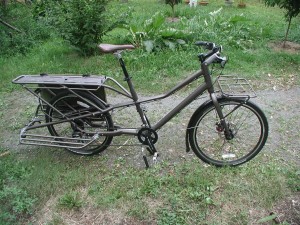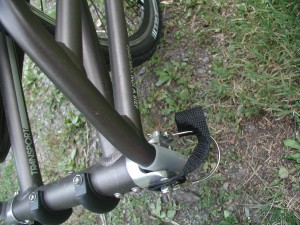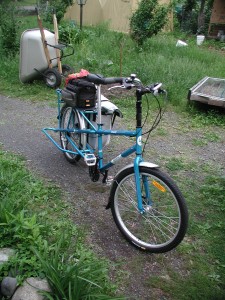 The other week I had the chance to try another cargo bike, the Trek Transport.
The other week I had the chance to try another cargo bike, the Trek Transport.
How this came about was that I took my Mundo in to get the front hub replaced with a hub dynamo, so I can mount lights on the bike. I had some cargo on the bike from other errands, so my loaner bike from the shop to ride home on became the Transport. Plus the guys at Laughing Dog already know my interest in this kind of biking, that helped too in getting a loaner bike built specifically to carry cargo.
First of all I am glad that a main-stream large company like the Trek attempts to market a cargo bike. That shows a trend, in which even a US company can think that the cargo market is big enough for them to enter into the ring. It also shows, that building a cargo bike takes skills, design and forethought. Hoping that it is useful info, why don’t I describe in what ways the Trek Transport and the Yuba Mundo are similar, and in what ways they are different. Let’s start with the similarities, as there are quite a few things that are similar about these bikes.
- Their cargo areas are relatively the same size,
- both come with a bottom cargo rack as well as an over-the-rear-wheel platform,
- they both look unique (and in my opinion are good looking),
- they both come in electric and non-electric version,
- they both ride smoothly, and feel similar to a normal bike,
- they also cost about the same: $1400 for the non-electric version, and double that for the electric.
Then many things are very different:
- First of all, when I unloaded the fifty pound chicken feed I was carrying on the Mundo, I put it onto the Transport, and it would have immediately fallen sideways, had I not caught it. Then I learned that even loading my basket on one side tips the bike easily, because of the kickstand is narrow, not very useful for holding up a cargo bike unless the load is almost perfectly balanced.
- This may be because the frame of the Transport is aluminum, so it is lighter than the Mundo. True, the carrying capacity of the Transport is half of the Mundo’s, but light is good, no? Until you put a larger cargo on the bike, and the Transport starts to flex and twist. So far I wasn’t able to cause this on the Mundo, even with lopsided loading: it holds its shape very well, which gives it a feeling of robustness that I appreciate. Another difference about the frame is that the Transport is available in two sizes. I can’t really add any plus or minus to that, since the one-size-fits-all Mundo fits very well to my own 6’4” frame.
- The Transport has a shorter wheel base, because the rear wheel is closer to the front of the cargo area than to the end of it. I needed to be careful where I put the load, as weight put on the rear end of the cargo area would lift the front of the bike up, or would make it even less stable as far as the sideway tipping is concerned.
- For some reason there is no rear fender on the Transport. It is easy enough to install one on it, but I wonder where else Trek tried to cutting cost like they did by just not installing a rear fender.
- Also there are less speeds on the Transport: only a double cog-set up front. I cannot run out of low gears on the Mundo, but I sure ran out of them on the Transport pretty soon.
 I like the fact, that the side supports for the Transport can fold up, lowering the width of the bicycle. On the Mundo this lower platform can fairly easily be uninstalled, but it involves using an Alan wrench on six screws, that doesn’t compare to the ease of folding the lower deck up on the Transport.
I like the fact, that the side supports for the Transport can fold up, lowering the width of the bicycle. On the Mundo this lower platform can fairly easily be uninstalled, but it involves using an Alan wrench on six screws, that doesn’t compare to the ease of folding the lower deck up on the Transport.- The Mundo gets the electric kit’s battery installed in the empty area between the rear wheel and the seat-tube. The battery for the Transport+ goes over the rear wheel, under the top cargo platform, raising it, and making the bike even less stable. This affects the loaded riding as well as the handling of the bike while pushing it loaded. And I do hope that battery is water proof, since ain’t no rear fender protects it:-)
- The Bread Basket on the Mundo (The front rack) is mounted to the frame, and this way it doesn’t affecting steering, which I love. On the Transport the front rack is fork-mounted, thus when loaded, it makes steering more awkward. Luckily it is considerably smaller than the Bread Basket.
- The bag for the Transport is much nicer than the bags of the XtraCycle kit. Sturdier, more protective against wet weather. But nothing can beat the bags of the Mundo: the oversized top cover not only protects from the weather even when the bags are very full, but it also provides flexibility which the zip on the Transport can’t. I also like the mounting on the Mundo’s Go-getter bag more. Easy to remove, but I know the bag will not fall off no matter how bumpy the ride is.

So what is my overall opinion? For me the differences boil down to the weaker aluminum frame of the Transport, and the rear wheel placement – those are the things I cannot change, and dislike. The weak inferior kickstand, rear fender and limited gears all can be changed. But why would I bother, when I can get a cargo bike that is extremely strong, and stable in addition of having a rear fender and better gearing? Plus I get to support a small company in this country instead of a multinational one.

Pingback: Trek Transport – Cargo Bike Review | Traversing Tulip Lane